Architecture Differences and Hydrocarbon Accumulation in Passive Continental Margin Basins in East Africa
Abstract
:1. Introduction
2. Exploration Overview in This Study Area
3. Restoration of Proto-Type Basins and Lithofacies Paleogeography
3.1. Intracontinental Aborted Rift Stage
3.2. Intracontinental-Intercontinental Rift Stage
3.3. Passive Continental Margin Stage
4. Differences in Basin Architecture and Sedimentary Evolution
4.1. Rifted Basins
4.2. Depressed Basins
4.3. Faulted Depression Basins
4.4. Reformed Delta Basins
5. Hydrocarbon Accumulation Rules
5.1. Rifted Basins
5.2. Depressed Basins
5.3. Faulted Depression Basins
5.4. Reformed Delta Basins
6. Conclusions
- (1)
- The passive continental margin basins in East Africa are a series of basins formed with the breakup of the East Gondwana and the formation of the Indian Ocean. During the Late Carboniferous-Triassic Karoo period, intracontinental aborted rifted proto-type basins were formed, filled with fluvial, lacustrine, and swamp deposits. During the Jurassic period, a new round of intracontinental-intercontinental rifted proto-type basins were formed, mainly in closed bays and lagoon sedimentary environments. At the end of the Jurassic period, carbonate rock was relatively developed, along with salt rock locally. Since the Cretaceous, they have been passive continental margin basins, dominated by open marine sedimentary formation. Affected by the volcanic orogeny since the Mesozoic and Cenozoic on the African continent, there are sufficient material supplies, and a series of delta-deep-water gravity flow sedimentary systems along the coast have been developed.
- (2)
- Passive continental margin basins have a “lower-rift and upper-depression type” basin architecture with widely developed rift sequences. Affected by the difference in sedimentary filling thickness between rift and depression periods, four types of basin architectures are formed: “rifted type,” “depressed type,” “faulted depression type,” and “reformed delta type.” The maximum sedimentary thickness of the rifted basins during the rift period is greater than 3500 m, and that during the depression period is less than 4000 m. The “depressed type” basins have underdeveloped rift sequences, with maximum sedimentary thickness during the depression period >4000 m. The maximum sedimentary thickness of the “faulted depression type” basins during the rift period is greater than 3500 m, and that during the depression period is greater than 4000 m. For “reformed delta type” basins, in addition to the larger sedimentary thickness of the early rift and the central depression, the thickness of the delta in the late depression since the Miocene is more than 4000 m, which forms four major unique structural belts, namely, growth fault, mud diapir, thrust nappe, and foredeep gentle slope. The deep-water slip-collapse-debris flow turbidity current in the sedimentary system increases with the increase in sedimentary thickness in the depression.
- (3)
- Due to differences in architecture and sedimentary filling, the four types of basins have significantly different hydrocarbon accumulation models, forming “single-source structure type,” “single-source fan group type,” “double-source and double-combination type,” and “three-source and multi-combination type” hydrocarbon accumulation models. Different types of basins have different exploration directions. The exploration of rifted basins should focus on large structural traps at the top of the rifted sequences. The dominant exploration directions of depressed basins are sedimentary sand bodies and structural-lithologic traps during the depression and drift periods. The main exploration targets for “faulted depression type” basins are the large slip-collapse-debris flow sedimentary sand bodies in the upper and middle slopes. Exploration and research of the reformed delta basins should focus on the four major structural belts.
Author Contributions
Funding
Institutional Review Board Statement
Informed Consent Statement
Data Availability Statement
Conflicts of Interest
References
- Dou, L.R.; Wen, Z.X.; Wang, J.J.; Wang, Z.M.; He, Z.J.; Liu, X.B.; Zhang, N.N. Analysis of the World Oil and Gas Exploration Situation in 2021. Pet. Explor. Dev. 2022, 49, 1195–1209. [Google Scholar] [CrossRef]
- Zhao, D.P. Seismic Structure and Origin of Hotspots and Mantle Plumes. Earth Planet. Sci. Lett. 2001, 192, 251–265. [Google Scholar] [CrossRef]
- Ebinger, C.J.; Sleep, N.H. Cenozoic Magmatism throughout East Africa Resulting from Impact of a Single Plume. Nature 1998, 395, 788–791. [Google Scholar] [CrossRef]
- Ma, J.; Liu, J.P.; Pan, X.H.; Wan, L.K.; Wang, X.L. Geological characters of the East and West Africa continental margins and their significance for hydrocarbon exploration. J. Chengdu Univ. Technol. Sci. Technol. Ed. 2009, 36, 538–545. [Google Scholar]
- Pei, Z.H. Regional petrogeological features of Africa and its prospecting potential. Nat. Gas Ind. 2004, 29–33+103–104. [Google Scholar]
- Mahanjane, E.S. A Geotectonic History of the Northern Mozambique Basin Including the Beira High—A Contribution for the Understanding of Its Development. Mar. Pet. Geol. 2012, 36, 1–12. [Google Scholar] [CrossRef]
- Klimke, J.; Franke, D.; Gaedicke, C.; Schreckenberger, B.; Schnabel, M.; Stollhofen, H.; Rose, J.; Chaheire, M. How to Identify Oceanic Crust—Evidence for a Complex Break-up in the Mozambique Channel, off East Africa. Tectonophysics 2016, 693, 436–452. [Google Scholar] [CrossRef]
- Roberts, D.G. Regional Geology and Tectonics: Phanerozoic Rift Systems and Sedimentary Basins; Elsevier: Amsterdam, The Netherlands, 2012; pp. 1–528. [Google Scholar]
- Wescott, W.A.; Diggens, J.N. Depositional History and Stratigraphical Evolution of the Sakamena Group (Middle Karoo Supergroup) in the Southern Morondava Basin, Madagascar. J. Afr. Earth Sci. 1998, 27, 461–479. [Google Scholar] [CrossRef]
- Bosellini, A. East Africa Continental Margins. Geology 1986, 14, 76–78. [Google Scholar] [CrossRef]
- Nichols, G.J.; Daly, M.C. Sedimentation in an Intracratonic Extensional Basin: The Karoo of the Central Morondava Basin, Madagascar. Geol. Mag. 1989, 126, 339–354. [Google Scholar] [CrossRef]
- Nilsen, O.; Dypvik, H.; Kaaya, C.; Kilembe, E. Tectono-Sedimentary Development of the (Permian) Karoo Sediments in the Kilombero Rift Valley, Tanzania. J. Afr. Earth Sci. 1999, 29, 393–409. [Google Scholar] [CrossRef]
- Winn, R.; Steinmetz, J.; Kerekgyarto, W. Stratigraphy and Rifting History of the Mesozoic-Cenozoic Anza Rift, Kenya. AAPG Bull. 1993, 77, 1989–2005. [Google Scholar]
- Wopfner, H. Tectonic and Climatic Events Controlling Deposition in Tanzanian Karoo Basins. J. Afr. Earth Sci. 2002, 34, 167–177. [Google Scholar] [CrossRef]
- Zhang, G.Y.; Liu, X.B.; Zhao, J.; Wen, Z.X.; Zhang, D.D.; Wang, Z.M.; Zhang, L.; Ma, F.; Chen, X. Passive continental margin basin evolution of East Africa and the main controlling factors of giant gas fields: An example from the Rovuma Bain. Earth Sci. Front. 2018, 25, 24–32. [Google Scholar] [CrossRef]
- Wen, Z.X.; Xu, H.; Wang, Z.M.; He, Z.J.; Song, C.P.; Chen, X.; Wang, Y.H. Classification and hydrocarbon distribution of passive continental margin basins. Pet. Explor. Dev. 2016, 43, 678–688. [Google Scholar] [CrossRef]
- Qin, Y.Q.; Zhang, G.Y.; Liu, J.G.; Chen, Z.M.; Xiao, G.J. Geological settings, hydrocarbon accumulation conditions and exploration prospects of deep-water oil and gas in East Africa. China Pet. Explor. 2022, 27, 110–121. [Google Scholar] [CrossRef]
- Dou, L.R.; Wen, Z.X. Classification and exploration potential of sedimentary basins based on the superposition and evolution process of prototype basins. Pet. Explor. Dev. 2021, 48, 1100–1113. [Google Scholar] [CrossRef]
- Leinweber, V.T.; Jokat, W. The Jurassic History of the Africa–Antarctica Corridor—New Constraints from Magnetic Data on the Conjugate Continental Margins. Tectonophysics 2012, 530–531, 87–101. [Google Scholar] [CrossRef]
- Dietz, R.S.; Holden, J.C. Reconstruction of Pangaea: Breakup and Dispersion of Continents, Permian to Present. J. Geophys. Res. 1970, 75, 4939–4956. [Google Scholar] [CrossRef]
- Scotese, C.; Gahagan, L.; Larson, R. Plate Tectonic Reconstructions of the Cretaceous and Cenozoic Ocean Basins. Tectonophysics 1988, 155, 27–48. [Google Scholar] [CrossRef]
- Salman, G.; Abdula, I. Development of the Mozambique and Ruvuma Sedimentary Basins, Offshore Mozambique. Sediment. Geol. 1995, 96, 7–41. [Google Scholar] [CrossRef]
- Edwards, J.D.; Santogrossi, P.A. Divergent/Passive Margin Basins; American Association of Petroleum Geologists: Tulsa, OK, USA, 1989; ISBN 978-1-62981-130-7. [Google Scholar]
- Leila, M.; El-Sheikh, I.; Abdelmaksoud, A.; Radwan, A.A. Seismic Sequence Stratigraphy and Depositional Evolution of the Cretaceous-Paleogene Sedimentary Successions in the Offshore Taranaki Basin, New Zealand: Implications for Hydrocarbon Exploration. Mar. Geophys. Res. 2022, 43, 23. [Google Scholar] [CrossRef]
- Shanmugam, G. New Perspectives on Deep-Water Sandstones: Origin, Recognition, Initiation, and Reservoir Quality; Handbook of Petroleum Exploration and Production; Elsevier: Amsterdam, The Netherlands, 2012; Volume 9, 524p, ISBN 978-0-444-56335-4. [Google Scholar]
- Shi, B.Q.; Ding, L.B.; Ma, H.X.; Sun, H.; Zhang, Y.; Xu, X.Y.; Wang, H.P.; Fan, G.Z. Characteristics of hydrocarbon accumulation in deep-water depositional system in offshore East Africa. Lithol. Reserv. 2023, 35, 10–17. [Google Scholar] [CrossRef]
- Deng, R.J.; Deng, Y.H.; Yu, S.; Hou, D.J. Hydrocarbon geology and reservoir formation characteristics of Niger Delta Basin. Pet. Explor. Dev. 2008, 35, 755–762. [Google Scholar]
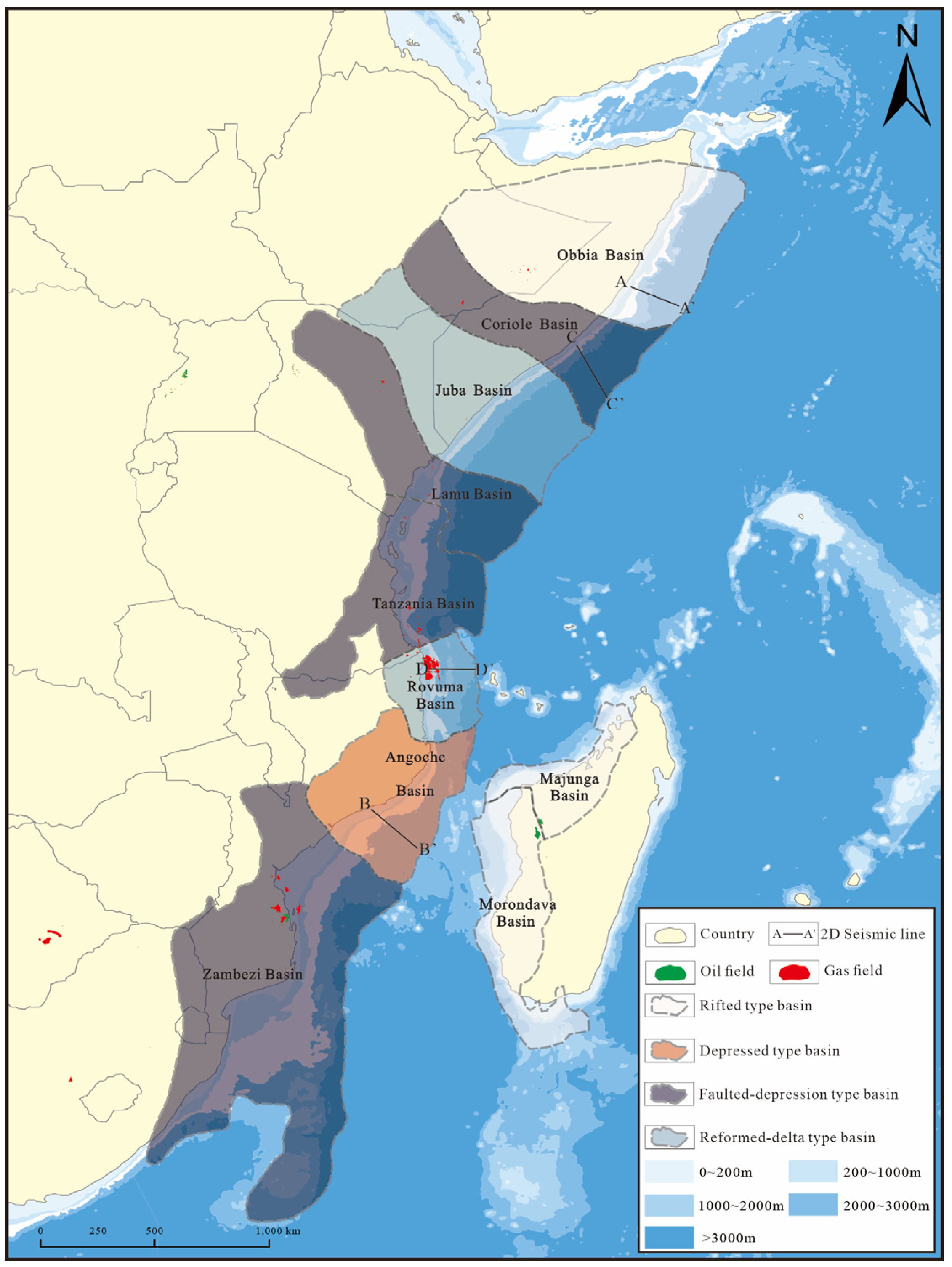
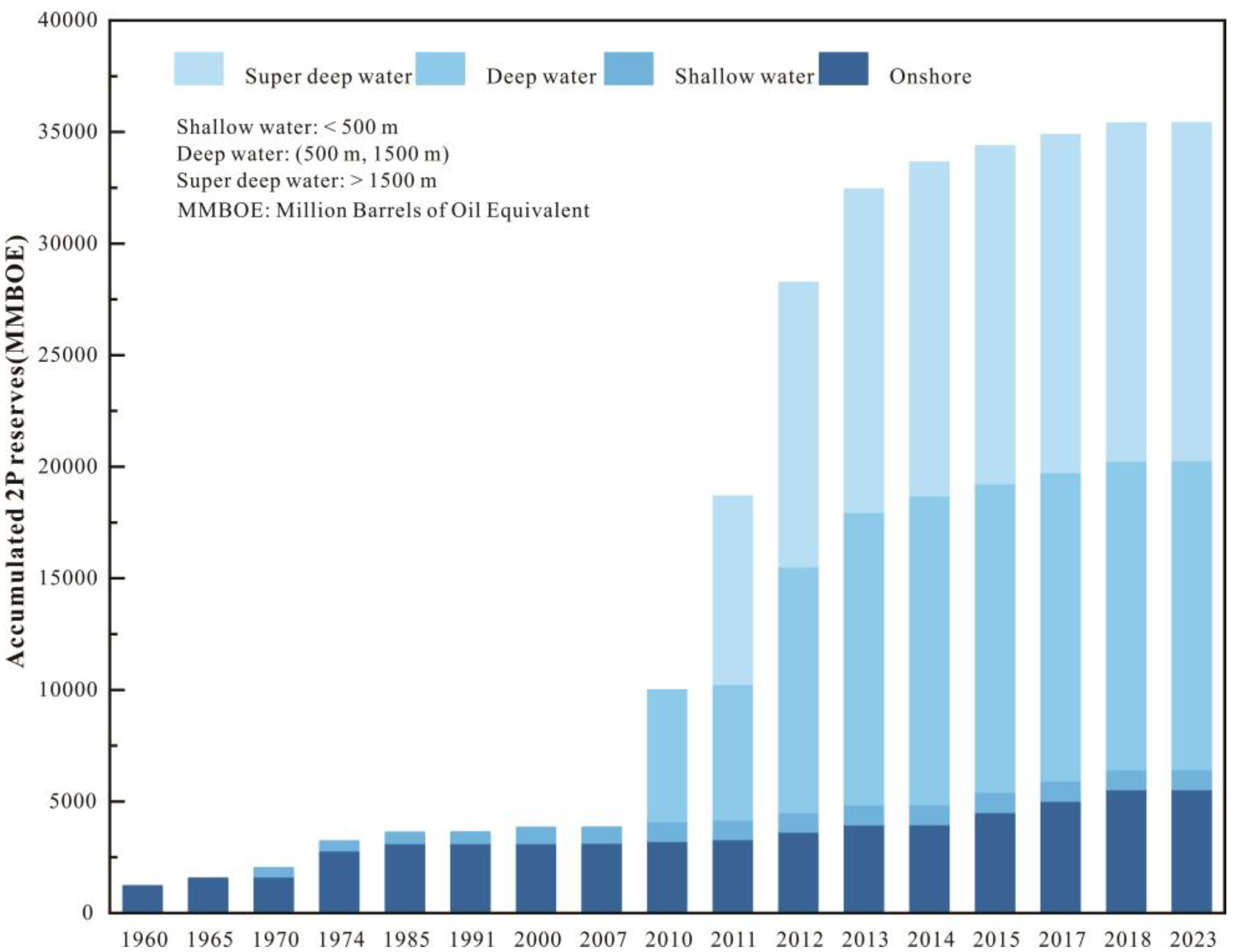



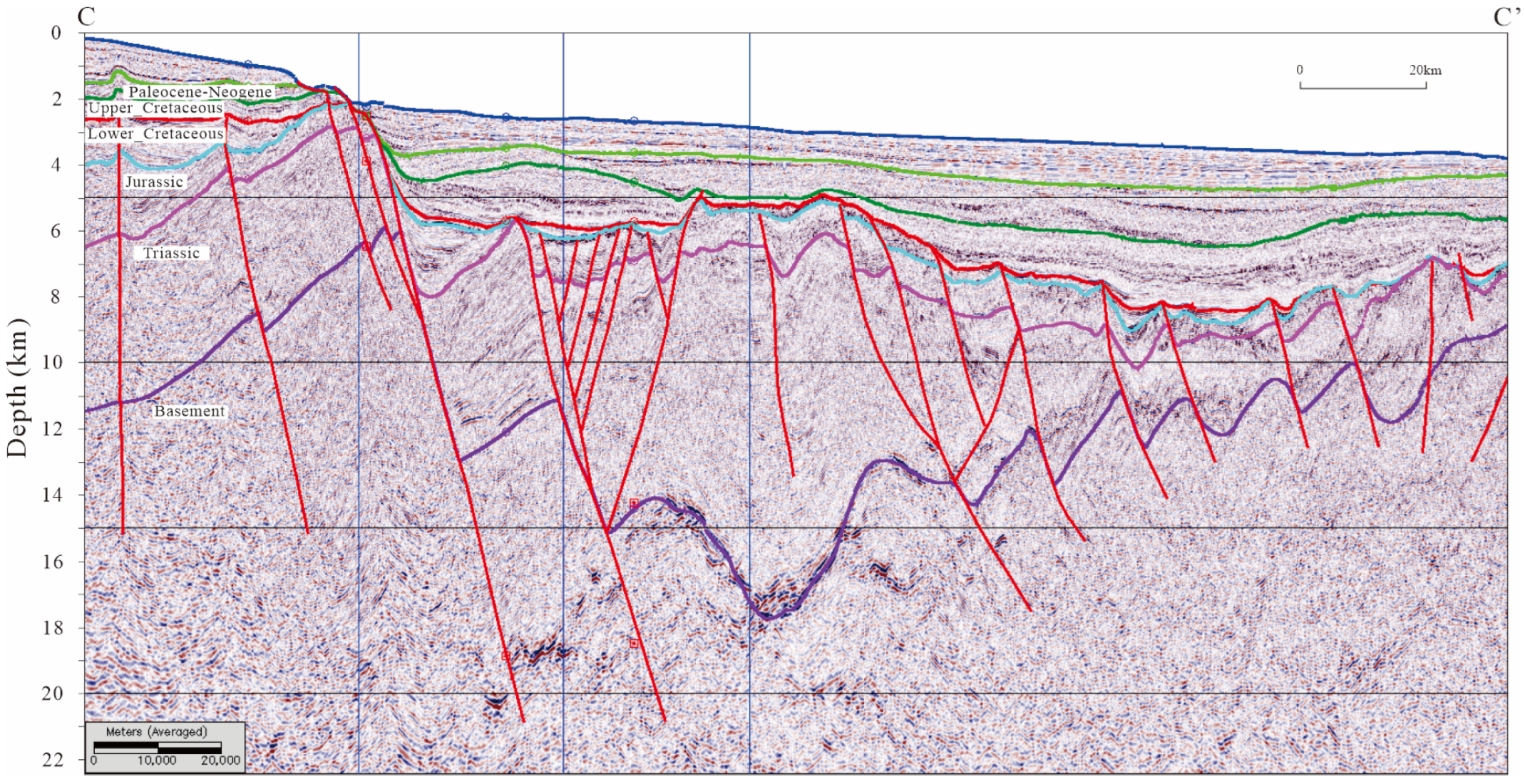

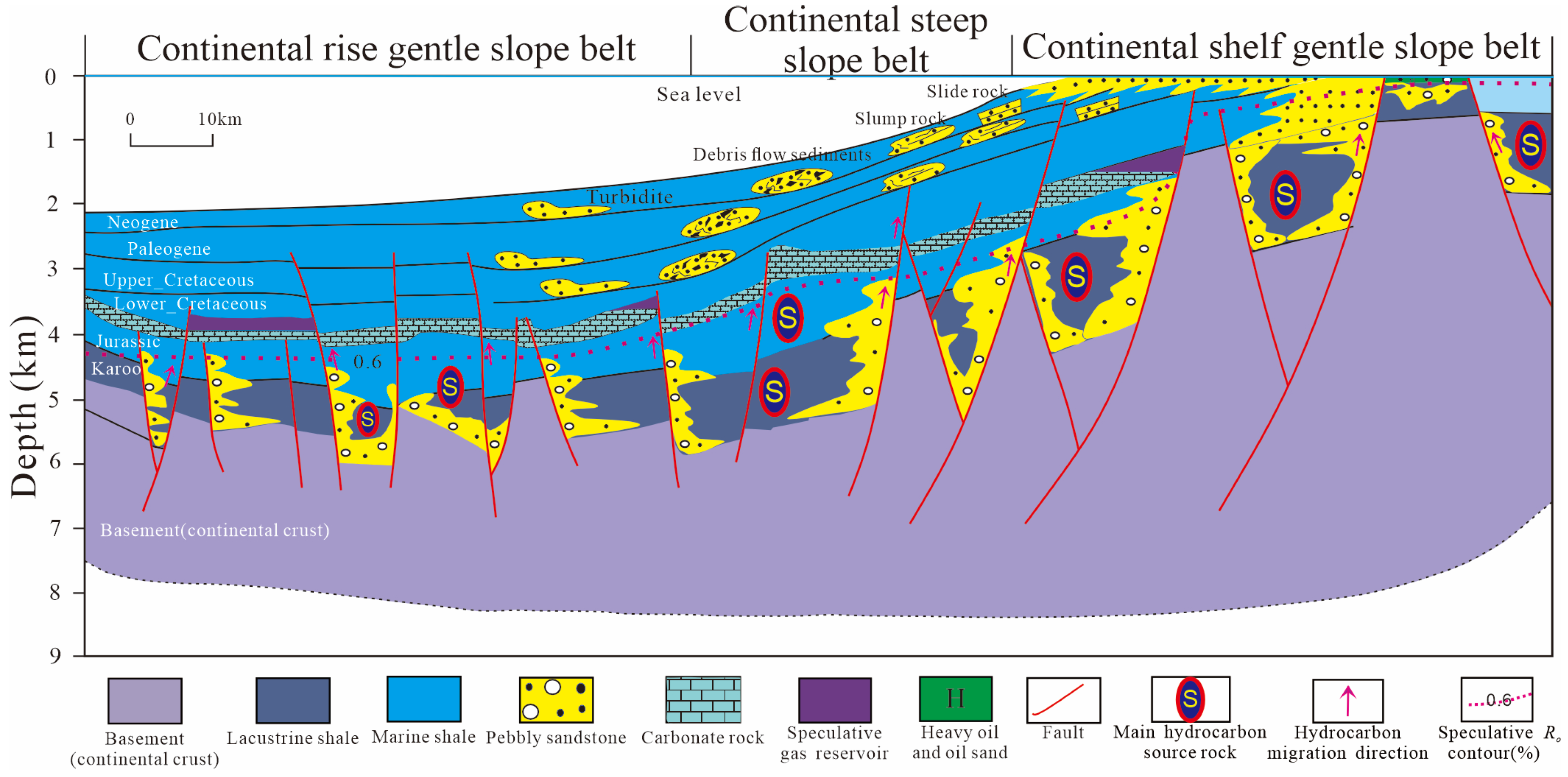
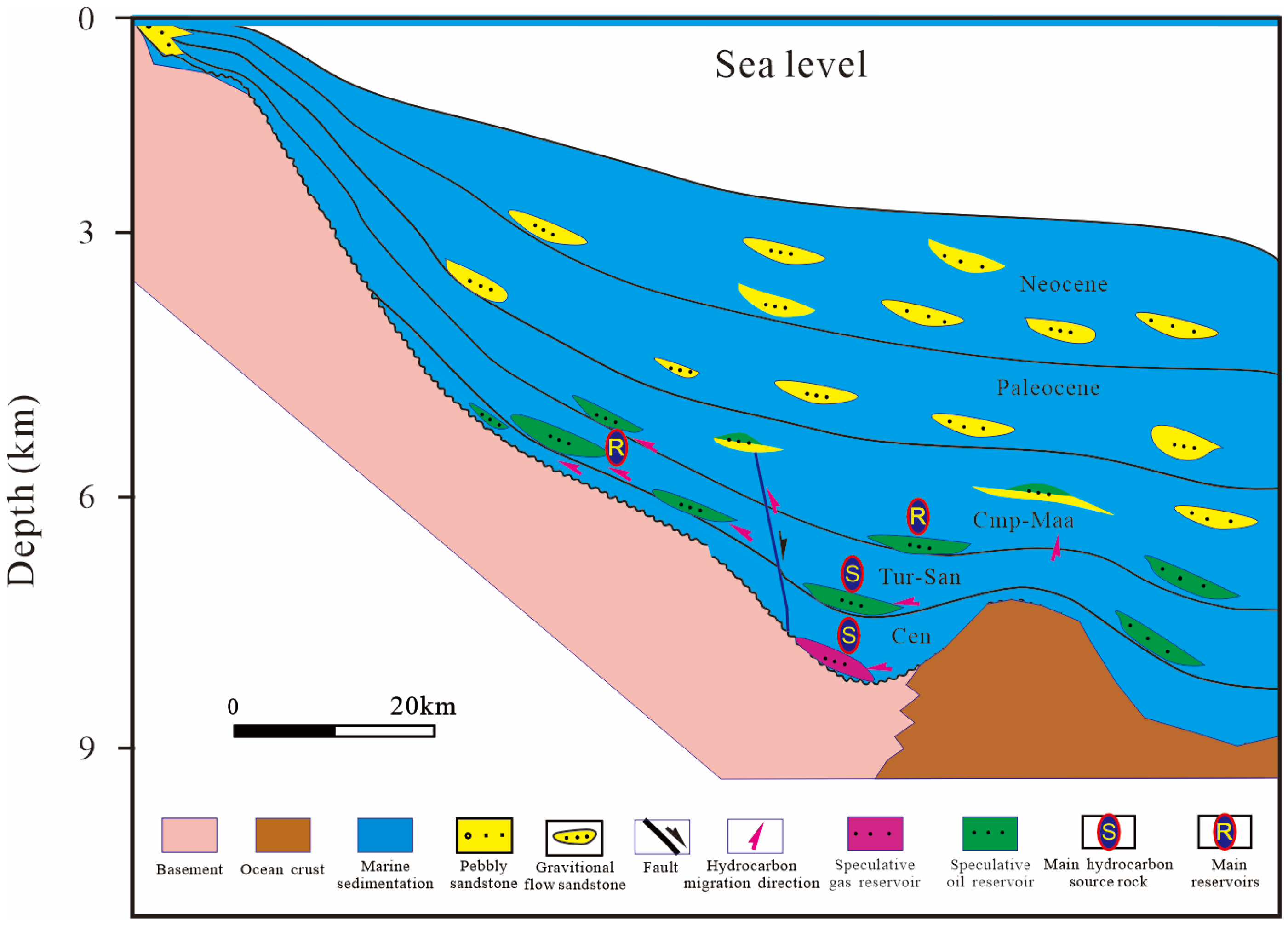
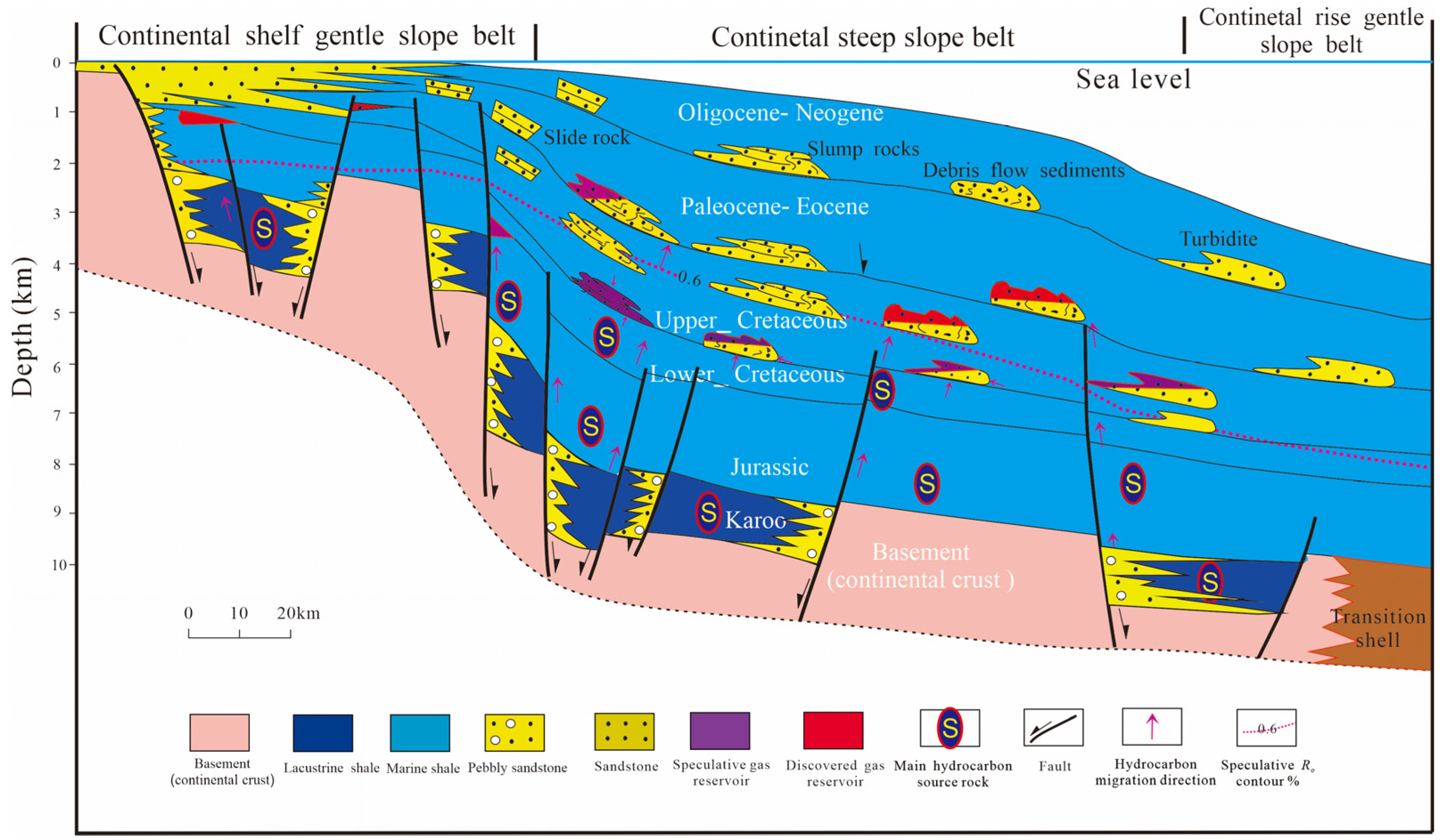
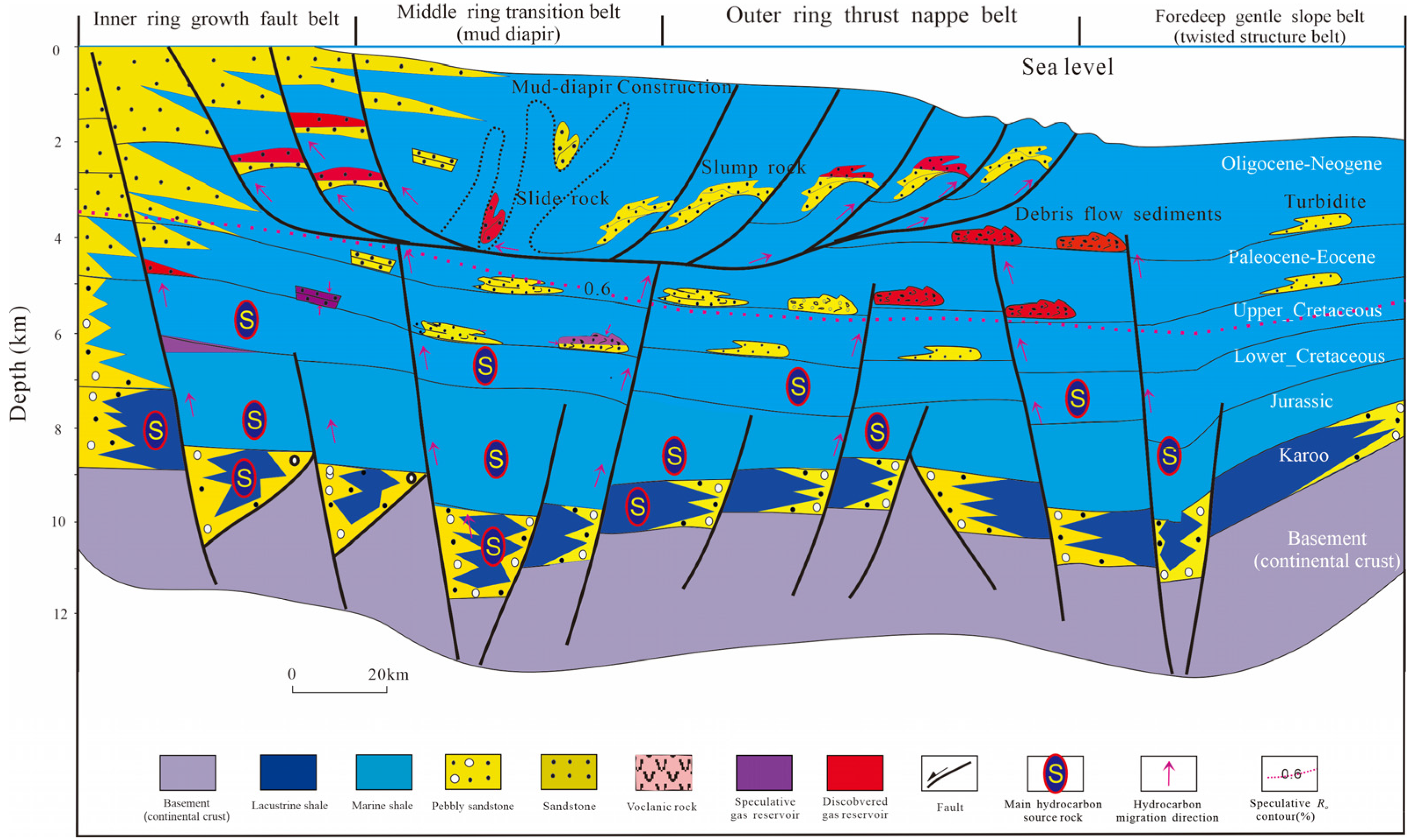
| Type | Hydrocarbon Accumulation Model | Sedimentary Filling | Typical Basin | |
|---|---|---|---|---|
| Vertical | Lateral | |||
| Rifted type | Lower rift and upper depression | Wide continental shelf and gentle continental slope | Mainly rift sequences (thickness > 3500 m), with thickness <4000 m during the depression period | Obbia and Morondava |
| Depressed type | Mainly depression | Narrow continental shelf and steep continental slope | Underdeveloped rift sequences and depression sequences > 4000 m | Angoche |
| Faulted depression type | Lower rift and upper depression | Wide continental shelf and gentle continental slope | Rift sequences > 3500 m, depression sequences > 4000 m | Coriole and Zambezi |
| Reformed delta type | Lower rift, middle depression, and upper convolution structure | Developing zonal structural belts from onshore to offshore | Both the rift stage and the depression stage are developed. Since the Miocene, a high constructive delta (thickness > 4000 m) has developed in the upper part | Rovuma and Juba |
| Subtype | Hydrocarbon Accumulation Model | Hydrocarbon Accumulation Rules | Typical Basin |
|---|---|---|---|
| Rifted type | Single-source structure type | High-quality source rock is formed during the rift period. Hydrocarbons are transported through the fault to a structural trap or structural-stratigraphic composite trap at the end of the rift period. Hydrocarbons are effectively sealed by the regional cap rock in the marine sedimentary area during the drift period. | Obbia and Morondava |
| Depressed type | Single-source fan group type | Effective source rock can be formed during the drift period, and gravity-flow sand bodies can be developed in the drift period to form the reservoir. Hydrocarbons are effectively sealed by the shale of the transgressive period. | Angoche |
| Faulted depression type | Double-source and double-combination types | Effective source rock can be formed in both the rift period and the depression period. The shallow-water region is mainly composed of structural play at the rifting end. The deep-water region is dominated by hydrocarbon accumulation in gravity flow sand bodies during the depression period. Both sets of source rocks can effectively supply hydrocarbons. Hydrocarbons are effectively sealed by the shale of the transgressive period. | Coriole and Zambezi |
| Reformed delta type | Three-source and multi-combination types | Effective source rock can be developed in rift, depression, and delta sequences. The shallow-water region and deep-water region can form a “double-source and double-combination type” hydrocarbon accumulation model similar to the faulted depression type. Hydrocarbons can accumulate in the four major structural belts from onshore to offshore in delta sequences. | Rovuma and Juba |
Disclaimer/Publisher’s Note: The statements, opinions and data contained in all publications are solely those of the individual author(s) and contributor(s) and not of MDPI and/or the editor(s). MDPI and/or the editor(s) disclaim responsibility for any injury to people or property resulting from any ideas, methods, instructions or products referred to in the content. |
© 2023 by the authors. Licensee MDPI, Basel, Switzerland. This article is an open access article distributed under the terms and conditions of the Creative Commons Attribution (CC BY) license (https://creativecommons.org/licenses/by/4.0/).
Share and Cite
Geng, K.; Wen, Z.; Wang, X.; Wang, Z.; He, Z.; Song, C.; Ji, T.; Li, H. Architecture Differences and Hydrocarbon Accumulation in Passive Continental Margin Basins in East Africa. Appl. Sci. 2023, 13, 11203. https://doi.org/10.3390/app132011203
Geng K, Wen Z, Wang X, Wang Z, He Z, Song C, Ji T, Li H. Architecture Differences and Hydrocarbon Accumulation in Passive Continental Margin Basins in East Africa. Applied Sciences. 2023; 13(20):11203. https://doi.org/10.3390/app132011203
Chicago/Turabian StyleGeng, Ke, Zhixin Wen, Xueling Wang, Zhaoming Wang, Zhengjun He, Chengpeng Song, Tianyu Ji, and Hengxuan Li. 2023. "Architecture Differences and Hydrocarbon Accumulation in Passive Continental Margin Basins in East Africa" Applied Sciences 13, no. 20: 11203. https://doi.org/10.3390/app132011203
APA StyleGeng, K., Wen, Z., Wang, X., Wang, Z., He, Z., Song, C., Ji, T., & Li, H. (2023). Architecture Differences and Hydrocarbon Accumulation in Passive Continental Margin Basins in East Africa. Applied Sciences, 13(20), 11203. https://doi.org/10.3390/app132011203





